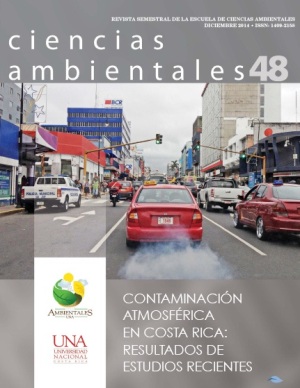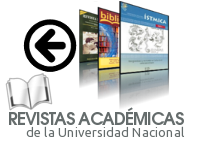Comparison of the chemical composition of PM10 and PM2.5 particles collected in urban environments and volcanic areas of metropolitan Costa Rica
DOI:
https://doi.org/10.15359/rca.48-2.5Keywords:
PM10, PM2, 5, air pollution, urban pollution, volcanic particlesAbstract
PM10 and PM2,5 were sampled simultaneously in urban and volcanic environments in the Metropolitan Area of Costa Rica from October to November 2012. Higher mass concentrations (42-29 μgm-3) of PM10 and PM2,5 were found at industrial and commercial areas with high traffic flow (La Uruca, Heredia and Belen) compared with those found in the volcanic areas. The daily concentrations of PM10 and PM2,5 obtained in the Poas Volcano ranged from 3 -14 μgm-3 and 2-11 μgm-3, respectively. However the acidity of the collected particles in the Poas volcano was higher than those sampled in urban environments probably due to a lower occurrence rate of neutralization. The contribution of secondary ions was more important to the volcanic PM10 composition (around 40%), unlike the PM10 collected in urban areas.
References
De Kok, T., Driece, H. A. L., Hogervorst, J. G. F. y Briedé J. J. (2006). Toxicological assessment of ambient and traffic-related particulate matter: A review of recent studies. Mutation Research 613, 103-122. http://dx.doi.org/10.1016/j.mrrev.2006.07.001
Englert, N. (2004). Fine particles and human health: a review of epidemiological studies. Toxicology Letters 149, 235-242. http://dx.doi.org/10.1016/j.toxlet.2003.12.035
Forster, P., Ramaswamy, V., Artaxo, P., Berntsen, T., Betts, R., Fahey, D. W., Haywood, J., Lean, J., Lowe, D. C., Myhre, G., Nganga, J., Prinn, R., Raga, G., Schulz, M. y Van Dorland, R. (2007). Changes in Atmospheric Constituents and in Radiative Forcing. En: Solomon, S., Qin, D., Manning, M., Chen, Z., Marquis, M., Averyt, K. B., Tignor, M. y Miller, H. L. (Eds.) Climate Change 2007: The Physical Science Basis. [Contribution of Working Group I to the Fourth Assessment Report of the Intergovernmental Panel on Climate Change]. Cambridge y New York: Cambridge University Press.
Herrera, J. (2009). Primer inventario de emisiones de contaminantes criterio del área Metropolitana: a-o 2007. CCAD-USAID.
Hueglin, C., Gehrig, R., Baltensperger, U., Gysel, M., Monn, C. y Vonmont, H. (2005). Chemical characterization of PM2,5, PM10 and coarse particles at urban, near city and rural sites in Switzerland. Atmospheric Environment 39, 637‐651. http://dx.doi.org/10.1016/j.atmosenv.2004.10.027
Husain, L., Dutkiewicz, V. A., Khan, A. J. y Ghauri, B. M. (2007). Characterization of carbonaceous aerosols in urban air. Atmospheric Environment 41, 6872-6883. http://dx.doi.org/10.1016/j.atmosenv.2007.04.037
Jacobson, M. Z. (2002). Atmospheric pollution. History, science and regulation. Cambridge: Cambridge University Press. http://dx.doi.org/10.1017/CBO9780511802287
Janssen, N. A. H., Brunekreef, B., Vliet, P., Arts, F., Meliefste, K., Harssema, H. y Fischer, P. (2003). The relationship between air pollution from heavy traffic and allergic sensitization, bronchial hyperresponsiveness, and respiratory symptoms in Duth schoolchildren. Environmental Health Perspectives 111, 1512-1518. http://dx.doi.org/10.1289/ehp.6243
Kampa, M. y Castanas, E. (2008). Human health effects of air pollution. Environmental Pollution 151, 362-367. http://dx.doi.org/10.1016/j.envpol.2007.06.012
Kappos, A. D., Bruckmann, P., Erikmann, T., Englert, N., Heinrich, U., Höppe, P., Koch, E., Krause, G., Kreyling, W. G., Rauchfuss, K., Rombout, P., Schulz- Klemp, V., Thiel, W. R. y Wichman H. E. (2004). Health effects of particles in ambient air. International Journal Hygiene and Environmental Heath 207, 399-407. http://dx.doi.org/10.1078/1438-4639-00306
Lee, J. T., Son, J. Y. y Cho, Y. S. (2007). The adverse effects of fine particle air pollution on respiratory function in the elderly. Science of the Total Environment 385, 28-36. http://dx.doi.org/10.1016/j.scitotenv.2007.07.005
Peters, A. (2005). Review: Particulate matter and heart disease Evidence from epidemiological studies. Toxicology and Applied Pharmacology 207, S477-S482. http://dx.doi.org/10.1016/j.taap.2005.04.030
Pope III, C. A., Burnett, R. T., Thun, M. J., Calle, E. E., Krewski, D., Ito, K. y Thurston, G. D. (2002). Lung cancer, cardiopulmonary mortality, and long-term exposure to fine particulate air pollution. American Medical Association 287, 1132-1141. http://dx.doi.org/10.1001/jama.287.9.1132
Rosenfeld, D. (2000). Suppression of rain and snow by urban and industrial air pollution. Science 287, 1793-1796. http://dx.doi.org/10.1126/science.287.5459.1793
Terzi, E., Argyropoulos, G., Bougatioti, A., Mihalopoulos, N., Nikolaou, K. y Samara, C. (2010). Chemical composition and mass closure of ambient PM10 at urban sites. Atmospheric Environment 44, 2231‐2239. http://dx.doi.org/10.1016/j.atmosenv.2010.02.019
Turpin, B. J. y Lim, H. J. (2001). Species contributions to PM2,5 mass concentrations: revisiting common assumptions for estimating organic mass. Aerosol Science and Technology 35, 602‐610.
Downloads
Published
How to Cite
Issue
Section
License

This work is licensed under a Creative Commons Attribution-NonCommercial-ShareAlike 4.0 International License.



















